I'm pleased to present this guest post courtesy of motorcycle innovator Robert Horn, who has spent several decades developing a series of machines that redefine the motorcycle by combining alternative suspension with two wheel steering into a recumbent chassis, which ultimately became the RoHorn racer. Here is Robert's story, in his own words:
Like old biplanes? Who doesn’t! They were once state of the art – those are what airplanes were supposed to look like - almost a century ago. Now imagine how progress in aviation would seem like if the only advances made since then were only with materials and electronics – would a carbon fiber covered titanium framed biplane with digital fuel injection sound like the peak of aviation development to you?
Would PlaneExif feature old aircraft with the latest developments in ironically inappropriate undercarriage tires, patina by numbers, and smug purveyors of artistically diminished airworthiness for the edgy iPilot? Well, that’s not too far off from what’s happened to the motorcycle world. For the high performance end of the market, how many years in a row of bold new graphics, .01mm smaller valve stems with 1.2 degrees less included angle for 2.4 more horsepower, and 17% more bodywork tortuosity does everyone have to get from press release regurgitators before everyone tunes out?
Are motorcyclists that braindead? I’m not innovation intolerant - if the OEMs won’t offer real innovation, fine, I’ll take that as an opportunity to do it myself. I don’t have any qualifications, credentials, or connections to do what I’m doing, but if the results from the qualified, credentialed, and connected are anything to go by, I’m better off for that.
I see the vast majority of the motorcycle industry as horrifyingly uninspired, unenthusiastic, and antipathetic. Look at any of the “Motorcycle Art” sites and bore yourself to death with endless images of Battle Tarts™ on dystopian café racers. How do you get that screwed up to think that’s exciting, attractive, or even remotely interesting? Am I the only one that doesn’t “Get it”? Maybe I need to look pretty far back to see why I’m headed the other way.
As a product of 1962, my early childhood was heavily influenced by that era’s boundless optimism and progress in aerospace, and having older brothers that enjoyed explaining it to me made it stick for life. The constant stream of new and exciting advances in aerospace meant there was always something interesting to learn. I couldn't wait to see what would come next: the future was going to be awesome! Then came the end of the Apollo program, the end of SST, XB-70, B-1A, etc. Well, one of my older brothers was also into homebuilt aircraft - the EAA’s Sport Aviation magazine introduced me to the excitement brought to that world at first by Jim Bede, then later by Burt Rutan. No need to wait for some factory or government program: the portal to the future is your own workshop, order that set of plans today!
Well, airplanes are really cool, fast, and all that, but they are still expensive to build, operate, and store. I soon concluded that motorbikes have the best !/$ ratio of any vehicle. Then while talking about motorcycle design, my older brother explained that if modern engineers were to start designing bikes for the first time, they would look very different, with vastly better aerodynamics, comfort, and chassis dynamics than bikes based on 19th century configurations. The only hints of such possibilities were the Mead & Tomkinson Nessie and Newell’s Quasar; to the teenage me, they seemed horrifically ugly, heavy, and misguided.
Then came motorcycling’s own era of boundless optimism and progress. The chopper fad imploded and the sportbike market exploded! The de Cortanze ELF racers hit both the tracks and the magazines. A GP class for the rest of us called “Battle of The Twins” started running at the national level. James Parker showed us what was possible with his RADD creations - his MC2 in Motorcyclist showed us that the future was going to be awesome! Tony Foale’s chassis book boosted my confidence on the subject of chassis dynamics and design. And if all those aircraft homebuilders could produce stunning aircraft, then how much easier should it be to produce a stunning motorcycle?
"Whenever there's a breakthrough, a true breakthrough, you can go back and find a time period when the consensus was 'Well, that's nonsense!' So what that means is that a true creative researcher has to have confidence in nonsense."
- Burt Rutan
While all of the other Funny Front Ends had logical explanations, I didn’t like any of them. Too many would illustrate their structural superiority with a side view of the load path, but none of them would illustrate that same path when seen from above – they’re worse than any fork from that direction. Wouldn’t it be really cool just to have 2 straight links in pure compression/tension? No way will that work, and I wanted to see for myself what would go wrong – except that it did work – on paper, anyway. Around the same time, Gene Church was dominating Pro-Twins BOTT racing on a Harley, while nobody seemed to be sure if Ducatis were still imported to the USA or even still in business In Italy. Is anyone going to take that company with an elephant logo seriously?
Harley was known to make engines without making any changes for decades (Unlike the 2 year engine design lifespan from the Big 4 at the time), and the new Evo engines had far greater performance potential than the previous generation. So I went with the Harley engine. Since so much of my new design was unproven, racing seemed like a bad idea for initial concept testing. Lovely yet hardly used roads were nearby (Sunspot, New Mexico), so the first bike project would be vaguely street legal. A new 1988 Sportster 883 was bought, torn down in the living room while my wife was away with relatives, and construction started in an unused 2nd bedroom.
I’d never built a motorcycle before, but books like the Aircraft Spruce & Specialty catalog, Carroll Smith’s excellent books, and the usual workshop books from Finch and Fournier got me started. The frame was made of 1” and 2” .065” wall mild steel cold drawn seamless tubing. The welding supply catalogs said that nickel silver brazed joints should be even stronger than welding, so that’s what I did. All of the tube fitting was done with a few hand files and a hacksaw – slow, but cheap. The engine was squared up to the table and stuck in position with bondo (AKA “Jig in a can”). Careful placement of tubing, with the assistance of my neighbor Ed Harthan’s fire resistant hands, made a frame jig unnecessary.
The only bent tube on the entire bike was the upper brace tube on the swingarm – packing the tube with sand, capping it, heating the bend area up with a rosebud torch, and hand bending it around a sheetmetal faced radius block got it done. The bodywork was carved then sanded from chunks of Styrofoam from Aircraft Spruce, fiberglassed with “Saf-T-Poxy” (...later banned because it apparently wasn’t safe enough), then smoothed out with Feather Fill and lots of wet sanding – just like building a composite homebuilt airplane! Afterwards, all of the foam was chipped out and/or dissolved out.
Some of the BOTT Harley roadracers used low oil sump placements, so that’s where mine ended up and I never had any oil feed issues. The board-track style exhaust pipes were the result of laziness, it was supposed to get a 2-1 exhaust system (and 1200cc big bore kit, etc.) but I just wanted to find out if the bike worked or not. And losing a few percent of horsepower on an engine that already made very little power made it hard to notice the difference. Both wheels were 18” Akront Nervi rims, just like the state of the art GSX-Rs at the time; I was never a fan of the 16” wheels that were popular elsewhere. The big “inside out” brake rotor was used to provide clearance for the virtual pivot arms; braking was a lot better than expected. The only problem was rapid pad wear, until race compound pads were installed.
The seat was shaped by assuming the position and hand forming a piece of perforated sheet metal to fit the interface area, then sandwiching it with fiberglass. Even with a quarter inch of foam rubber, it was an all-day comfortable seat, or at least it was for 135-pound twenty-something me. The only handling issues were an occasional vague weave, which would go away as soon as the steering system rod ends were oiled. That’s why I didn’t use Teflon lined rod ends, as stiction in the pivots will make an otherwise good steering system unrideable. By keeping the virtual pivot arm forward rod ends as close together as possible, 3 inches apart, the usual steering weirdness associated with the OEC Duplex was completely avoided.
Much about that project was printed in an article featured in the October 1991 issue of Motorcyclist magazine. I thought media exposure would change everything; all I had to do next was brace myself for the inevitable onslaught from rabid enthusiasts heaving large sacks of cash at me to build them exotic HD powered sportbikes!
Yeah, no, that didn’t happen. Maybe it’s because it was based on a Sportster and not a Big Twin – everyone knows which one gets the Big Money! But as well as the first one worked, it wasn’t race proven. So clearly another secret to success is racing! Sell that first project at a huge loss and build that Big Twin racer now!
The engine/primary/transmission assembly was lifted out of my 1988 FXRS-SP and mounted inside a new frame and suspension system. Then, no matter how I approached it, it was impossible to escape the fact that the primary case was going to hit the ground long before it cornered at serious lean angles, even with a custom offset chain drive sprocket. After facing all of that and a lot of other design details that weren’t thoroughly thought through, the engine was sold, the leftovers were thrown out, and interest in designing and building what I thought were going to be seen as two-wheeled Cobras came to an end.
"Research is what I'm doing when I don't know what I'm doing."
- Wernher von Braun
By this time Ducati was back in the game and winning races with the 851/888 series. Harley became a peddler of lifestyle accessories with no apparent interest in roadracing competitively (competently?) anymore.
A few years earlier Kevin Cameron published an article in the January 1987 issue of Cycle magazine explained why Funny Front Ends weren’t really going to do much and that two-wheel steering could change everything - in theory. I thought that was nonsense; FFEs make everything better at braking and turn-in! I delighted in late braking with my first project far later than I’d have ever dared with other bikes and their icky telescopic forks, and then flicking it in for a late apex and hammering the throttle out of the corner. Well, that sure is the most exciting way to make riding at 7/10ths feel fast on the street, but it isn’t really fast. And while the front end always remained totally composed with tons of feel, it was the back end that started to alarm me by feeling like it was going to come up and hit me in the back of the head under hard braking braking.
No amount of component rearrangement would change the fact that motorcycles dynamically become virtual unicycles at the extreme ends of performance. Kevin was right - the only way to significantly increase performance is use both tires all of the time by increasing the wheelbase and steering both wheels. How do you do that? Well, if national security depended on it (Peace Through Superior Lap Times), it wouldn’t be a problem, but my last name isn’t DARPA and I don’t have Skunk Works budgets or facilities. None of the chassis theoreticians had any relevant experience or even helpful opinions on the subject; there’s no prior art available. But I really want to know what it feels like to go a lot faster - a challenge that ought to be a lot of fun.
By this time, the BOTT class was eliminated and national club racing had gone entirely to factory production based formulas. Silly peasant, motorcycle racing isn’t about racing: it’s about OEMs and organizers! Those icky bike builders in shabby vans with no advertising budgets shall not sully the gleaming row of race transporters and mobile hospitality suites in the pits any longer! Well who needs the AMA anyway when the local racing clubs are alive and well with accommodating rules? But which engine? Which class? What’s the Next Big Thing?
Bob Brant’s excellent 1993 EV book, Alan Cocconi’s electric Honda CRX conversion, the GM EV1, the threat of an EV mandate in California, and later, the AC Propulsion T-Zero made the challenge of designing and building a high performance electric motorcycle racer seem like a very exciting opportunity. Having enough kilowatt hours to get a few laps worth of screams and giggles meant that the bike would probably have about a quarter ton of lead-acid batteries – the far superior lithium battery pack would have cost well into 6 digits and was a nightmare to manage. Performing two-wheel steering system stability and control experiments with a fast heavy motorcycle sounded like a really bad idea.
A rear steering mixer was designed that would infinitely vary both the front to rear steering ratio and the relative direction, but having a two axis steering control with just a handlebar wasn’t feasible. And the anticipated stretched out kneeling position was a source of weight distribution, structural, and ergonomic nightmares, even if it looked totally radical.
A visit to a bicycle shop presented an unexpected solution.
I’d previously regarded recumbent bikes as contrarian contraptions, generally ridden by old guys with degenerative personality disorders. But here in front of me at that bicycle shop was an old Ryan recumbent with a long wheelbase and an aerodynamic yet comfortable rider position which eliminated all of the kneeler design issues – the perfect configuration. I sit corrected! And for that two axis control, well, just replace the remote handlebar pivot with an aircraft-style control stick! So I built a lightweight test version of that electric racer that was in my head out of fillet brazed 7/8” and 1-1/8” (which fits nicely in cheap conduit benders) mild steel tubing. This time, a full frame fixture was built out of straight lengths of wood lath – good for one time use only, but cheap, easy, and effective. I then discovered that tubes could be held in place with a small blob of Bondo – by the time they were tacked together, the heat would pop off that blob cleanly and the brazed joint could be finished.
An order was placed for two high-speed Heinzmann electric hubs from a shop in England, before such hubs became illegal in Europe and unobtainable elsewhere. All of the other hard-to-find electrical bits and pieces came out of the KTA Services catalog, a pre-internet gold mine for EV builders. The bike minus the batteries weighed about 70 pounds, and the 3 lead-acid “U1” batteries also weighed about 70 pounds. The bike handled somewhat like an airplane – tilting the stick to the left made the front wheel turn to the right, which made the bike roll to the left. That’s just basic counter steering in action, but it still took a lot of unlearning/relearning before I could relax while riding.
The stick was in two wheel steering/same direction mode almost all of the time – the only time it went into opposite mode was in very low speed sharp corner/U-turn situations. And the biggest surprise came from just going around in a fixed circle with different rear steering ratios – the more both ends steered in the same direction, the smaller the lean angle – none of the steering theoreticians predicted that. While the two-axis control stick was invaluable for testing, it was not a viable racer control system. Since then, the bike has served as a lovely suspended decoration in my living room.
The budget still wasn’t there to build a full sized electric racer, but by then the Go-Ped craze was peaking – all sorts of cheap little bits and pieces were available for their 23cc engines. And there was even a local racing series held in large hotel parking lots around Denver and elsewhere. A 2WS Go-Ped powered ultra-low recumbent racer was built and tested. The 2WS system’s 2:1 F/R steering ratio reduced lean angles a lot, making it easy to ride hard and slide around; front end slides didn’t result in an instant lowside. I figured that I could make and sell frame kits with little trouble; a humble start in motorsports, but a great way to introduce the 2WS concept to the world and an opportunity to grow towards far greater things!
Cycle World expressed interest in both the 2WS Go-Ped racer and the 2WS/2WD electric test bike. Supposedly, articles were written, including one by Kevin Cameron, only to get canned. I don’t know why and never got to read them, but I still have the pictures that were taken for the article.
Unfortunately, the Go-Ped craze soon imploded, taking the racing series and aftermarket with it. My machine spent the next few years hanging over my desk – my favorite kind of art. Then it became a depressing reminder of what didn’t happen – nothing new was discovered with it anyway - the engine was sold, and the leftovers were thrown out.
By now, there was enough information to proceed with confidence on a real 2WS motorcycle. There were also a new set of unknowns, but there’s only one way to find out. All of the known methods and techniques used to make virtual unicycles work would probably have detrimental effects on a bike that actually uses both tires for traction all of the time.
Is a 50/50 weight distribution going to make the back end step out since it doesn’t transfer enough weight to the rear end under acceleration, or would a rear end weight bias work better, especially since the rear tire is wider than the front? Are long swingarms dynamically beneficial or just stress multipliers for a long wheelbase bike? Since total weight transfer isn’t happening anymore, is a half foot of suspension travel even necessary? Is a regressive spring rate a good idea with a lot less travel? Is anti-squat on the throttle/chatter off the throttle rear end geometry still a good idea? Would some front end brake dive help stabilize the chassis during the transition between braking and cornering? Will linked brakes be effective? What’s wrong with having steering geometry that works well all of the time?
The more you study about what others know about motorcycle dynamics, the more you find out that they really don’t know anything at all other than: “This is how we’ve always done it - it’s the proper way”.
The budget was nil, again, but low-interest credit cards were easily obtained at the time – why, it would be foolish not to proceed, jump through that wide-open window of opportunity now! So the racer was designed to be dirt cheap and easy to build using an EX500 donor bike. It wouldn’t be competitive, but at least it would tell me if I was going in the right direction. The 16” wheels hurt it a lot since no race tires fit them, but the shape of the wheel hubs made the machine work a lot easier, especially for the split hub center steering on the rear hub.
Ideally, this sort of work would be done under contract from a large company and tested in top secret on proving grounds that don’t show up on maps, with only the fully developed production model revealed to the public many years later. But that’s not how the Backyard Industrial Complex works. It was built in my garden shed with square and rectangular steel tubing - no fancy frame jig required – 3D geometric precision through C-clamps and angle iron. All of the welds were done with a nice little Lincoln MIG unit and cost nothing in labor. All of the machining was done in my kitchen with a small cheap lathe/mill combination machine – very slow, but it made a lot of perfectly good parts when it was too cold/dark/wet to work in the shed.
The bodywork was also kept as simple as possible, while still trying to keep it from being as ugly as possible. Parts which could have been lightened considerably weren’t; as good as lighter parts are in a racer, additional hours of work delay the answer to the most important question: Will it even work?
 |
| Image courtesy Tracy Helmhold |
It did work! The local club (MRA) and local track (High Plains Raceway) were really cool about letting me race with them - I can’t say enough good things about them. And even though it wasn’t competitive, operating it in a competitive environment generated far more valuable experience than just renting the track and droning around with the intent to make haste on the next lap, not to mention socially engaging, and even a lot cheaper. Real racing at a real race track stimulates a mindset that can’t be simulated.
"The building of the bike is possibly the most interesting part of it. But, I suppose, unless you're prepared to go through with putting it against the racing world, well, then, you've really proven nothing."
- John Britten
 |
| Image courtesy Michael Moore |
After the last race, it was going to become another living room fixture. But then I had an opportunity to show it off at the 2019 Quail event, which sounded like a good excuse to take it out one last time. The Quail event was a lot of fun – I got positive coverage from some enthusiastic writers and met a lot of interesting people. I'm glad we went.
 |
| Image courtesy Michael Moore |
After a quarter century of electric racer dreaming, the time to wake up and actually make one is at hand - or so I’m told. While I would dearly love to build and race the electric racer that’s in my head (I’m very jealous of my mental test rider – he’s entered countless races, smashed lap records, and loves it…), my next racer will have an internal combustion engine for 2 reasons: weight and cost. Until you see a successful season of high performance air racing with electric airplanes, you won’t see a successful season of high performance roadracing with electric motorcycles for identical reasons. As long as I’m using my available credit rather than someone else’s large sack of cash to finance the next racer, leaded racing gas mixed 20:1 with castor oil is still the key to optimizing that !/$ ratio and making the future awesome.
Check out Robert's photo gallery for more cool pictures of his work.
"This new form will have to be a complete concept - not just a mass of little improvements. It is hard to prove the advantages of wings by attaching them to a toad; they really do work best on a bird. To leap from the toad to the bird is generally too radical a step for conservative business corporations. They have invested too much money in producing better toads.
The novel concepts, therefore, come from nutty individuals, many of whom seem to like change for its own sake. Because of this they can make mistakes that make even their good ideas appear laughable; consequently, these ideas must wait until traditional thinking is completely bankrupt. Then they are widely adopted and labeled 'progress'."
 |
| Contribute to OddBike on Patreon |

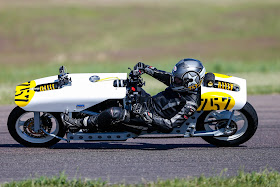

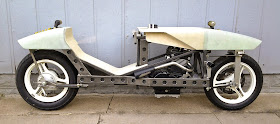


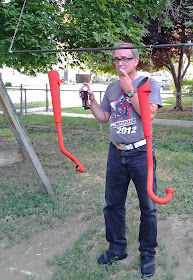

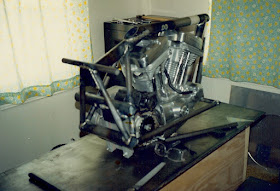


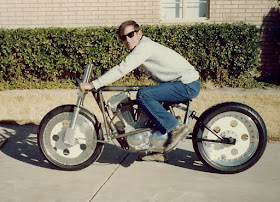
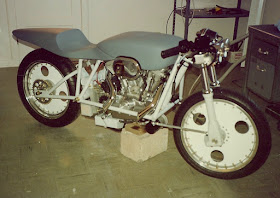

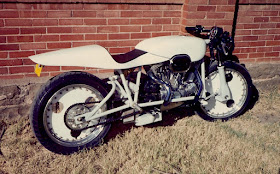

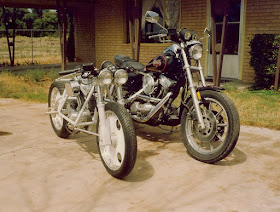



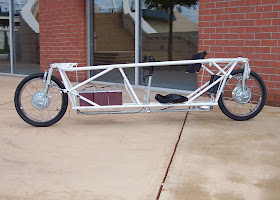

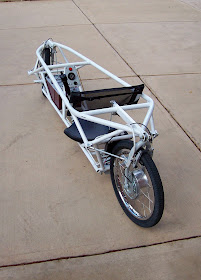





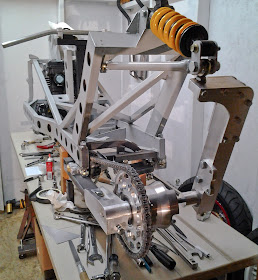
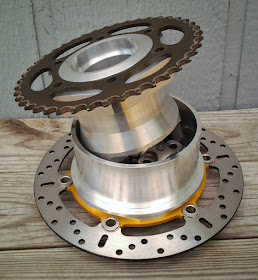

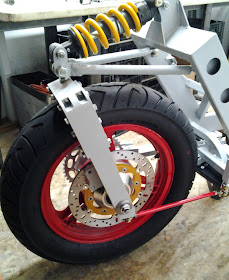






I really enjoyed that and smiled throughout it! If it only motivates one person in a million that will be eight thousand around the World. Well done indeed Rob!!
ReplyDeleteMr. Horn, I like what you've done here, and I'd like one of these machines for myself. I have pretty good 3D CAD skills, and hundreds of dollars. I also have a good relationship with a very good, somewhat affordable, metal fabrication shop located in SE Michigan. How can I assist you in your future work, and thereby build up enough sweat equity to someday obtain a rolling chassis similar to the one profiled in this article? Yours only half-jokingly, Phil in SE Michigan
ReplyDeleteA prophet is without honour in his own country...
ReplyDeleteNever a truer word!
Genius stuff here.
Very fascinating
ReplyDeleteHold on a minute! The second to last picture just made it dawn on me! Rear, driven wheel also needs to steer? How does the sprocket transmit rotation to the center hub, and still be able to turn/tilt relative to chassis??? Pure genius!
ReplyDeleteHi Robert,
ReplyDeleteI became semi fascinated about funny front ends when I undertook a biography of the late John Britten. Now it seems I am semi fascinated by funny rear ends as well! The only thing holding me back from full fascination of both was the opinion of a number of significant riders that raced the Britten that they would have done better with a set of forks. Robert Holden in particular always pushed John to change over/back to forks. One rider explained that it was akin to developing a better wheel barrow. However I find your work truly inspiring and I am sure John would have too.
This comment has been removed by the author.
DeleteA hearty "Thank you!" from a fan of your work! I still have the Britten book - the Newcombe book is in good hands...
DeleteThat Akira reference at the end of text was awesome. Everything about construction of this motorcycle is beautiful to me, it's the first time that i see how much we're losing by thinking that the way we always done it is only proper way.
ReplyDeleteRob is my new favourite motorcycle designer. I often daydream about how a motorcycle might evolve and it seems Rob has combined just about every idea I thought might have been original: virtual steering pivot, long and low for good traction, multi-wheel steering, electric motor for the front wheel. The only addition from my wish-list would be multiple small wheels. Why stop at two, when you could have 5 smaller steered go-kart wheels like an inline skate, all with smaller hub motors. Steering would need to be fly-by-wire I think
ReplyDeleteGreat, thought-provoking writing with an entertaining style to describe an achievement that, while still evolving, can stand on its own as remarkable within the motorcycle historical timeline.
ReplyDeleteI very much like the aerial pic of Bob walking towards "it". There's a quality of the bike being alive more than any other custom largely due to a revolution it possesses.
wow
ReplyDeleteHi Robert, big fan of your work and out-of-the-box vision ! Keep up the good work, m next FeetFirst should also be a lightweight electric one :-)
ReplyDeleteNext…two wheel drive?
ReplyDeleteIan Drysdale- Melbourne Australia- 2 wheel drive,2wheel steer, 2stroke. Needs to add your FFE and recumbent. I have been an interested observer from the days of the English Qasar and feet forward movement, 40?yrs ago. Dan Gurneys efforts also deserve respect, but is any manufacturer ever going to break the mold. I think we will never see it and die in hope.
DeleteYes - 2 wheel drive and 2 wheel steering - under construction with a KTM 890 engine.
DeleteNice post thank you Tim
ReplyDeleteThis article on the ROHORN TWO from Odd-Bike is a fascinating deep dive into a truly unique motorcycle design. The innovative engineering and attention to detail are impressive, especially how Robert Horns crafted a bike that blends artistry with functionality. Learning about the development process and the challenges faced in creating such a distinct machine adds another layer of appreciation. It's inspiring to see how passion and creativity can push the boundaries of motorcycle design. Thanks for sharing this insightful piece!
ReplyDeleteWow loved this post so much I went to youtube to find footage, you should totally include the video in your post!
ReplyDeletehttps://www.youtube.com/watch?v=tb0jtYGOw2s
" . . . Too many would illustrate their structural superiority with a side view of the load path, but none of them would illustrate that same path when seen from above – they’re worse than any fork from that direction . . . "
ReplyDeleteProof that Mr Horn doesn't fully understand or appreciate the Loads on a Single-Track Vehicle (Motorbike).
The Side (Lateral) Loadings on a Motorbike Fork (on a Solo Bike) are so insignificantly minor that they can be virtually ignored.
That thinly disguised 'dig' at the alternative Front-End Designs of Messers Hossack and Foale (to name but two) is entirely unjustifiable.
You obviously don't understand the load that heavy braking places on the front end - those curved front swingarms aren't a "Direct load path" that their creators claim.
DeleteNeither can you explain why the vast majority of FFEs ever used in racing suffer from "Hop" rather than "Chatter" - hop is the result of gross structural inadequacies - a failed attempt at solving real problems by creating even bigger problems: Fior (Same as Hossack) and ELF racers both did that.
In other words, you don't know what you're upset about...
You really should discuss my work with Norman and Tony yourself before you go any further with this subject...
ReplyDelete